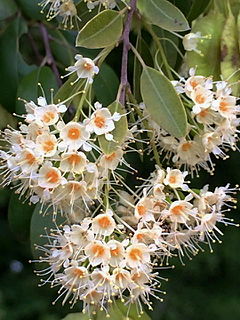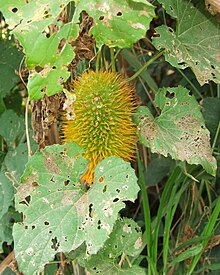
Momordica charantia is a tropical and subtropical vine of the family Cucurbitaceae, widely grown in Asia, Africa, and the Caribbean for its edible fruit. Its many varieties differ substantially in the shape and bitterness of the fruit.

Marah are flowering plants in the gourd family (Cucurbitaceae), native to western North America. They are also commonly called Old man in the ground. The genus was named for Marah in Exodus 15:22–25, which was said to be named for the bitter water there.

Passiflora foetida is a species of passion flower that is native to the southwestern United States, Mexico, the Caribbean, Central America, and much of South America. It has been introduced to tropical regions around the world, such as Southeast Asia, South Asia, Hawaii, Africa, and The Maldives. It is a creeping vine like other members of the genus, and yields an edible fruit. The specific epithet, foetida, means "stinking" in Latin and refers to the strong aroma emitted by damaged foliage.

Momordica is a genus of about 60 species of annual or perennial climbers herbaceous or rarely small shrubs belonging to the family Cucurbitaceae, natives of tropical and subtropical Africa and Asia and Australia. Most species produce floral oils and are visited by specialist pollinators in the apid tribe Ctenoplectrini. A molecular phylogeny that includes all species is available.

Rubus saxatilis, or stone bramble, is a species of bramble widespread across Europe and Asia from Iceland and Spain east as far as China. It has also been found in Greenland.
Balsam apple may refer to:

Cucurbitacin is any of a class of biochemical compounds that some plants — notably members of the pumpkin and gourd family, Cucurbitaceae — produce and which function as a defence against herbivores. Cucurbitacins are chemically classified as triterpenes, formally derived from cucurbitane, a triterpene hydrocarbon – specifically, from the unsaturated variant cucurbit-5-ene, or 19(10→9β)-abeo-10α-lanost-5-ene. They often occur as glycosides. They and their derivatives have been found in many plant families, in some mushrooms and even in some marine mollusks.

Acalypha indica is an herbaceous annual that has catkin-like inflorescences with cup-shaped involucres surrounding the minute flowers. It is mainly known for its root being attractive to domestic cats, and for its various medicinal uses. It occurs throughout the Tropics.

Wrightia tinctoria, Pala indigo plant or dyer's oleander, is a flowering plant species in the genus Wrightia found in India, southeast Asia and Australia. It is found in dry and moist regions in its distribution. Various parts of the plant have been used in traditional medicine, but there is no scientific evidence it is effective or safe for treating any disease.

Momordicin I, or 3,7,23-trihydroxycucurbitan-5,24-dien-19-al, is a chemical compound found in the leaves of the bitter melon vine, possibly responsible for its reputed medicinal properties.
Karaviloside is any of several related cucurbitane triterpenoid glycosides found in bitter melon vine. They include:
Charantin is a chemical substance obtained from the Asian bitter melon, reputed to be responsible for the hypoglycaemic properties of those plants. It was identified by Lolitkar and Rao in 1960. It was also found in the similar African species M. foetida, by A. Olaniyi in 1975, under the name foetidin.

Momordica cymbalaria is a vine of the genus Momordica found in the Indian states of Andhra Pradesh, Karnataka, Madhya Pradesh, Maharashtra, and Tamil Nadu. It is a relative of the bitter melon plant. The plant has also been named Luffa tuberosa (Roxb.) or Momordica tuberosa (Roxb.)

Cucurbitane is a class of chemical compounds with formula C
30H
54. There are a polycyclic hydrocarbon, specifically triterpene. There are isomers of lanostane, from which it differs by the formal shift of a methyl group from the 10 to the 9β position in the standard steroid numbering scheme.
A kuguaglycoside is one of several chemical compounds isolated from the roots of the bitter melon vine by J.-C. Chen and others.
A kuguacin is one of several chemical compounds isolated from the bitter melon vine by J.-C. Chen and others.
A momordicine is any of several compounds found in the bitter melon vine, Momordica charantia. They are glycosides of cucurbitane derivatives. They include

Raphia farinifera is a tropical African palm tree occurring in lowland riparian and swamp forest, also around human habitations and cultivated locations, on stream banks and other moist situations at altitudes of 50–1000 m. Found in Angola, Benin, Burkina, Cameroon, Gambia, Ghana, Guinea, Ivory Coast, Kenya, Madagascar, Malawi, Mauritius, Mozambique, Nigeria, Réunion, Senegal, Seychelles, Sierra Leone, Tanzania, Togo, Uganda, Zambia and Zimbabwe, and naturalised in Madagascar. Its genus is derived from 'raphis' = needle, probably in reference to the 4 mm long yellowish spines on the margins and main veins of the leaflets. The specific name refers to a type of starchy flour obtained from the trunk pith – 'farina' = starch, 'fera' = bearing.

Pteleopsis myrtifolia is one of some 10 African species in this genus in the family of Combretaceae. It is the only Pteleopsis species to occur in Southern Africa. Its flowers are strongly scented and perceived by humans to be either 'honey-like' or 'cloying' or even 'stinky'. The timber is red, hard and durable, and used for furniture and construction.
Drypetes gerrardii is a species of small tree or large shrub in the family Putranjivaceae. Common names include forest ironplum, bastard white ironwood, and forest ironwood. It is native to tropical and subtropical central and eastern Africa. It was first described in 1920 by the English botanist John Hutchinson, who named it after the English botanist William Tyrer Gerrard who collected plants and seeds in southern Africa in the 1860s.















